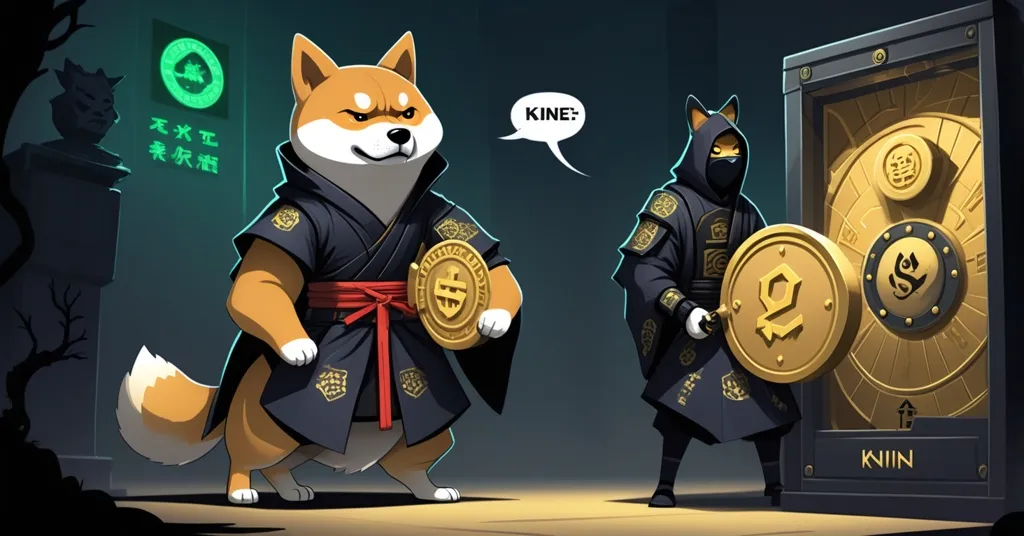Shiba Inu’s Final Offer: 20 ETH Bounty for Shibarium Hacker Before Deadline

Shiba Inu Team’s Final Stand: 20 ETH Bounty for Shibarium Hacker Before Clock Runs Out
The Shiba Inu team, together with K9 Finance DAO, has thrown down a last-ditch ultimatum to the hacker who exploited the Shibarium bridge in mid-September. Return the stolen KNINE tokens and claim a 20 ETH bounty—or face the consequences. With the reward set to decay starting November 18, 2024, and expire completely on November 25, 2024, this high-stakes chess move, detailed in an on-chain message, is a bold attempt to resolve the breach without diving into the messy world of litigation or worse.
- Last Chance: 20 ETH bounty escrowed for the return of stolen KNINE tokens.
- Time Limit: Bounty begins to decay on November 18, 2024, and expires November 25, 2024.
- Exploit Origin: Shibarium bridge hacked in mid-September via a validator-key compromise.
The Exploit: How It All Went Wrong
In mid-September, the Shibarium bridge—a vital piece of infrastructure for the Shiba Inu ecosystem—was breached in a sophisticated attack. The hacker used a flash-loan-aided validator capture to pull off the heist. For the uninitiated, a flash loan is a DeFi tool where you borrow a massive sum without collateral, but you must repay it within the same transaction. Think of it as renting a bulldozer for five seconds to smash a vault, then returning it before the owner notices—except here, it manipulates digital systems. In this case, the attacker exploited a validator-key compromise, essentially stealing the master key to Shibarium’s vault, authorizing a malicious state, and draining assets in the form of KNINE tokens.
These stolen KNINE tokens, however, are now a digital albatross around the hacker’s neck. The Shiba Inu team has blacklisted them, rendering them untradeable and worthless—imagine holding a stack of counterfeit bills no one will touch. While the exact value of the stolen tokens at the time of the hack hasn’t been publicly disclosed, the impact on trust and community sentiment is palpable. Shibarium, launched in August 2023 as a layer-2 scaling solution to reduce transaction costs for SHIB users and power DeFi applications, positions its bridge as a critical highway between blockchains. But this highway got hijacked, exposing a glaring vulnerability in the system. For more details on the ultimatum issued to the hacker, check out the latest update on the Shiba Inu team’s final offer.
The Bounty: A Decentralized Deal with Teeth
Initially, K9 Finance DAO, a decentralized organization tied to the Shiba Inu ecosystem, offered a measly 5 ETH bounty in mid-September to recover the tokens. The hacker laughed it off, demanding a hefty 50 ETH—like they were bartering over stolen goods at a shady flea market. That counteroffer was promptly shot down. Now, after a tense stalemate, the stakes have been raised to 20 ETH, securely escrowed in a verified Ethereum contract named “KnineRecoveryBountyDecayAcceptMultiFunder” (address: 0x5EA2…D4d0), created by k9dev.eth. This isn’t just a handshake deal; it’s a trustless, atomic settlement. In plain terms, both parties swap assets instantly—KNINE tokens for ETH—with the blockchain ensuring no one gets double-crossed.
The urgency was hammered home in an on-chain message sent on November 3, 2024, at 06:32 UTC, laying out the terms with a hard deadline.
“Dear Shibarium Bridge Hacker… New 20 ETH bounty to return stolen KNINE tokens. Settlement is atomic when we call recoverKnine(). KNINE is transferred back to Shibarium bridge and ETH is transferred to you. Bounty will start to decrease in 21-days (Nov 18)… [and] will expire in 28 days (Nov 25).”
Shiba Inu developer Kaal Dhairya didn’t mince words either, taking to X with a blunt nudge to the hacker, dripping with equal parts frustration and pragmatism.
“Yo, Shibarium bridge attacker, wake up—grab free cash before the offer expires this time and do something right.”
K9 Finance, speaking through The Shib Magazine, framed this escalation as a final act of good faith before the gloves come off.
“Makes good on a public promise… to extend one final, larger bounty offer to the entity behind the Shibarium Bridge exploit.”
This isn’t just about recovering assets; it’s a calculated play rooted in crypto’s decentralized ethos. Bounties via smart contracts sidestep the sluggish, often clueless world of traditional courts, offering a faster, cleaner resolution to blockchain disputes. But let’s play devil’s advocate for a second: doesn’t this approach risk rewarding bad actors? Why not target every bridge if there’s a chance of a payout instead of a prison cell? On the flip side, in a space where legal recourse is often toothless across borders, what’s the alternative? The fuse is burning short, and the hacker’s next move will set a precedent.
Community Fallout and the Scammer Surge
Hacks like this don’t just hurt project teams; they ripple through communities, shaking trust and inviting a second wave of predators. Scammers—those vultures circling a fresh carcass—have already started swarming. Fake X accounts, phishing sites, and bogus “KNINE recovery” portals are popping up, promising to help for a fee. Spoiler alert: it’s just a second theft. Both Shiba Inu and K9 Finance have sounded the alarm, urging users to steer clear of impostors and malicious links. It’s the ugly underbelly of crypto: every major breach breeds hustlers, and users often pay the price for letting their guard down.
As of now, Shiba Inu (SHIB) trades at $0.00000907, a price that seems detached from this drama amid the usual rollercoaster of meme coin volatility. But price isn’t the real story here. Trust in Shibarium’s security, and by extension Shiba Inu’s ambition to evolve beyond a mere meme token into a serious DeFi player, hangs in the balance. If this 20 ETH bounty—already a massive jump from the initial 5 ETH—doesn’t tempt the hacker, K9 Finance has signaled this is the end of structured negotiations. What comes next could be a legal slugfest or other undisclosed measures, neither of which bodes well for a quick resolution.
Bigger Picture: The Curse of Cross-Chain Bridges
Zooming out, the Shibarium exploit isn’t an isolated fiasco—it’s a symptom of a systemic weak spot in blockchain tech. Cross-chain bridges, which shuttle assets between different blockchains to enable interoperability, are notorious honeypots for hackers. Their complex architecture and the sheer value of assets they handle make them prime targets. History backs this up: the Ronin Bridge lost a staggering $624 million in 2022, while Wormhole bled $320 million the same year. Shibarium’s breach, though likely smaller in scale, echoes the same Achilles’ heel in DeFi security.
For Bitcoin maximalists, this might elicit a smug chuckle. Bitcoin’s base layer doesn’t rely on fragile bridges or flashy loans to function—it’s a fortress of simplicity by design. But let’s be real: altcoin ecosystems like Shiba Inu and Ethereum carve out niches Bitcoin can’t (and perhaps shouldn’t) fill, from meme-driven communities to sprawling DeFi experiments. The trade-off? They bleed for their ambition. Innovation in blockchain often sprints ahead of security, leaving projects—and their users—patching holes after the damage is done. The question isn’t whether bridges are inherently flawed, but whether security can catch up before the next big hack.
Key Questions Unpacked: Cutting Through the Noise
- What sparked the Shibarium bridge exploit?
A flash-loan-aided validator capture in mid-September allowed the hacker to manipulate the bridge’s state and siphon off KNINE tokens—a textbook DeFi exploit targeting weak links in complex systems. - Why dangle a 20 ETH bounty instead of jumping to legal action?
It’s a pragmatic move—bounties via trustless contracts align with crypto’s decentralized roots, offering a quicker, cleaner fix than courts, which often fumble blockchain disputes across borders. - Are the stolen KNINE tokens truly worthless to the hacker?
Absolutely. Blacklisted by the Shiba Inu ecosystem, they’re untradeable and valueless—like holding a bag of Monopoly money with no board to play on. - What’s at stake for the community if this deal falls through?
Beyond a potential shift to litigation, a failed resolution could erode confidence in Shibarium’s security, while scammers exploiting the chaos pose a direct threat to unsuspecting users. - Do incidents like this expose fatal flaws in cross-chain bridges?
Not fatal, but damning. Their complexity and high-value targets make them hacker bait—security must outpace innovation if projects like Shibarium are to survive the long haul. - How does this tie into the broader crypto revolution?
It’s a litmus test for DeFi’s maturity. We champion decentralization and disruption, but hacks like this remind us that freedom comes with friction—can we build without breaking?
This isn’t just Shiba Inu’s fight; it’s a snapshot of the growing pains facing the entire blockchain space. We stand for decentralization, privacy, and shaking up the financial status quo, but we’re not blind to the rough edges. Cross-chain bridges are crucial for a multi-chain future where Bitcoin’s raw strength meets the niche utility of altcoins—yet every step forward risks a stumble if security lags behind. For now, all eyes are on whether this hacker grabs the 20 ETH lifeline or digs in deeper. Either way, the crypto world watches, learns, and braces for what’s next. This saga isn’t over—it’s a warning shot for what’s at stake as we accelerate into uncharted territory.



